Reps could be missing out on 76% of qualified leads by not doing any follow-up activity. See what other data is saying with these sales follow-up statistics.
24 Sales Follow-up Statistics & Takeaways to Drive Revenue
This article is part of a larger series on Sales Management.
Following up with leads after an initial conversation, cold email attempt, or product demo is essential to move them to the bottom of the sales funnel and, ultimately, close deals. It enables you to determine if the prospect is ready to make a purchase or needs a little push to make a buying decision.
One of the challenges sellers experience is ensuring prompt and consistent reconnection attempts through sales follow-up with proper messaging, channels, and timing. Here are 24 sales follow-up statistics to help you optimize your nurture campaigns and messaging to drive revenue numbers.
Key Takeaways
- Reengagement is a numbers game: Attain a higher success rate by sending up to three follow-up emails.
- Artificial intelligence (AI) plays a significant role in follow-up: 28% of salespeople say increasing confidence is their top priority, working with buyers who use AI for product research.
- The right follow-up can resolve major challenges: Two of the biggest challenges of sales professionals are making direct contact with decision-makers (16%) and hitting their sales quotas (75%). Asking the right questions can get key players into the room and improve close rates.
Lead Follow-up Statistics on Cadence & Activity
These sales follow-up stats on leads are all about rep input. While you can’t always control the outcome, you can manage the effort you put into a single lead or opportunity. Sales teams can measure this by the number of touches and cadence of their follow-ups.
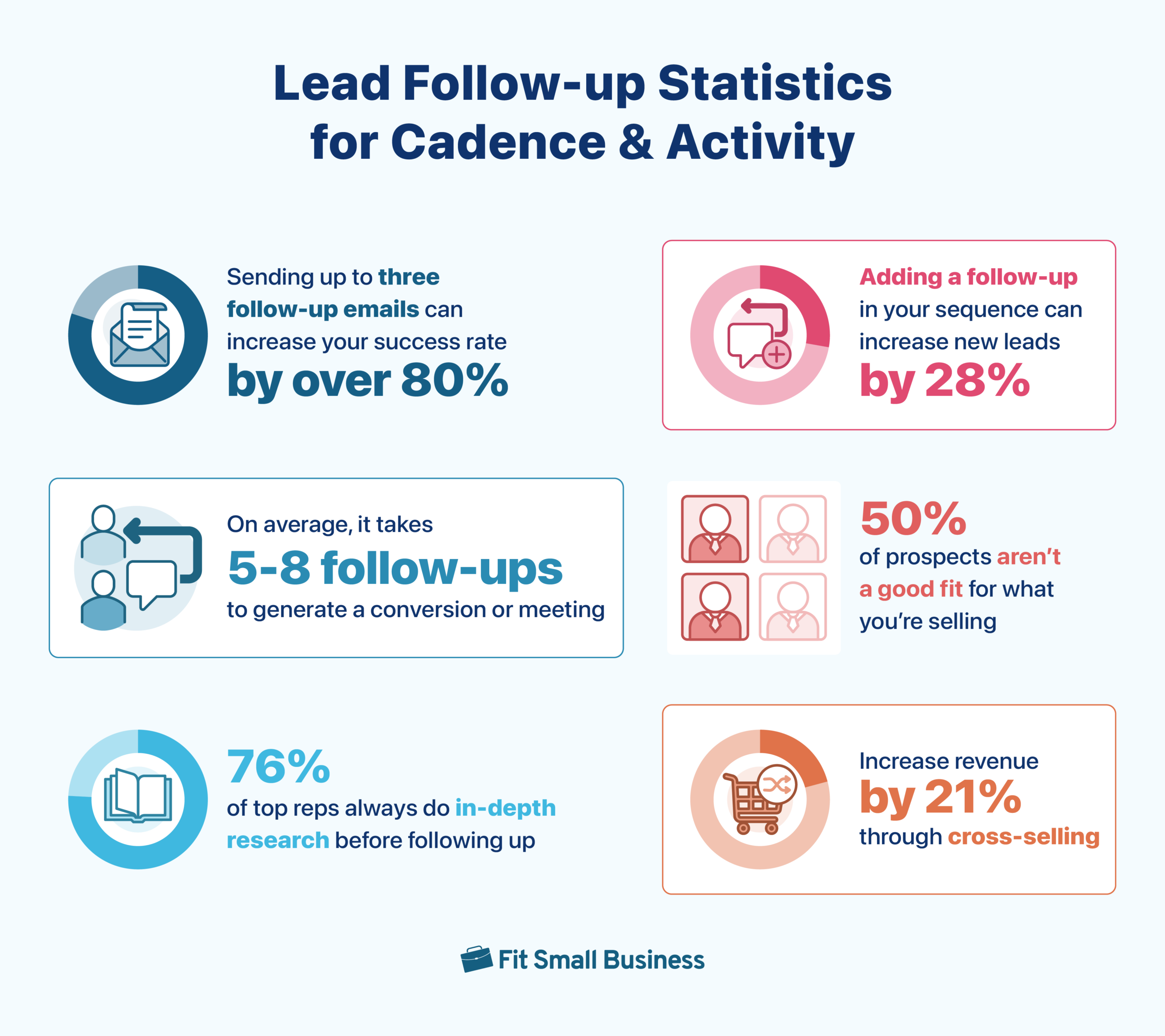
Lead follow-up statistics for cadence and activity to help sales reps plan and implement more effective strategies to reengage with prospects.
1. Sending up to three follow-up emails can increase your success rate by over 80%
As a sales manager, you should set activity quotas according to outreach. Success isn’t necessarily about reaching out to a specific number of prospects. It’s about how often your team sends follow-up emails to new and existing leads. You can’t close deals with only an initial contact. Follow-ups must be a part of sales planning, which is one of the key aspects of sales management.
2. On average, it takes 5-8 follow-ups to generate a conversion or meeting
One-and-done doesn’t work in sales. Reps must continuously call or email prospects after the first attempt to get a conversion. This applies to a product demo, sales meeting, or a prospect agreeing to receive additional marketing materials. Consider this when planning out your weekly task load.
3. 76% of top-performing reps always do in-depth research before following up with prospects
There’s a clear relationship between putting in the time to prepare for follow-up touches and sales results. Because understanding your prospects’ unique challenges is essential to sales, reps should learn as much as possible about their leads before engaging and reengaging them.
Creating personalized follow-up emails is a great way to entice leads to respond promptly and express their needs and preferences more openly.
4. Adding a follow-up in your sequence can increase new leads by 28%
The data for these particular sales statistics on follow-ups examined the value of email sequences. While 70% of reps stop after one email, 76% of all generated leads come from the first, second, or third “chaser” and not the initial introduction.
The most notable finding was that just one follow-up accounts for 28% of the lead pool. So it’s time to incorporate either manual or automated sequences in your sales campaigns.
5. 50% of prospects aren’t even a good fit for what you’re selling
Unless you’ve done your due diligence before sending outreach campaigns, half of the lead pool should be removed from your follow-up sequences because of the lack of fit. Instead, go back to the idea of in-depth research. You must take time to understand each prospect and ensure they fit into your ideal customer profile.
6. Increase revenue by 21% through cross-selling
About 87% of salespeople cross-sell, which drives nearly a quarter of revenue. Sales teams can send follow-up emails to existing customers after upselling or suggesting a higher-value product or service. Similarly, sales reps can follow up on post-sale experiences and recommend complementary offerings.
With effective upselling and cross-selling strategies, reps enjoy more sales opportunities and give customers options while engaging with them. As a result, your small business can generate higher revenue.
Customer relationship management (CRM) software like HubSpot can support reps completing follow-up activities. These products offer tools for creating effective sales reports to track rep activity and evaluate lead conversion rates. Tracking and reports can help reps achieve the ideal number of emails, calls, and meetings necessary to close deals and meet revenue goals.
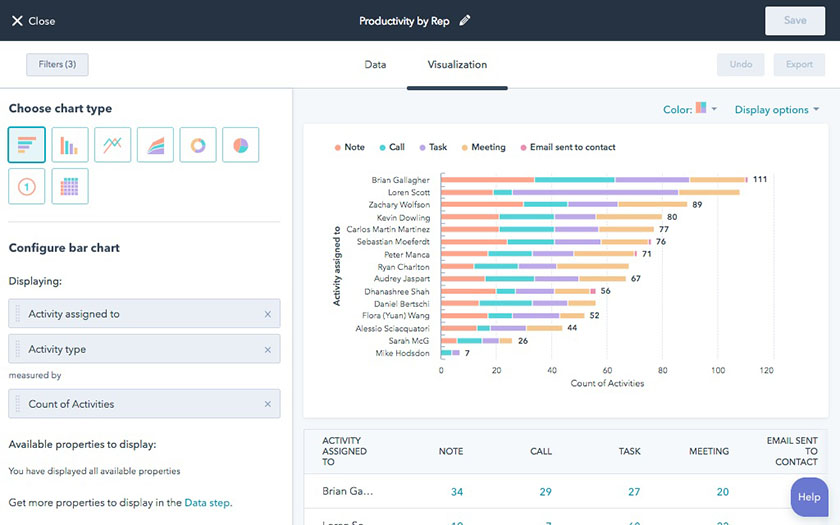
HubSpot CRM lets sales reps monitor lead activities in a detailed report to inform decision-making and create better sales follow-up strategies. (Source: HubSpot)
Sales Follow-up Stats on AI
AI is a significant emerging technology that allows sales reps to automate outreach, data management, and insights-gathering activities on leads, letting them do more in less time. As a tool for sales follow-ups, AI has become a key player in outbound volume and messaging quality. Check out the AI-related sales follow-up statistics.
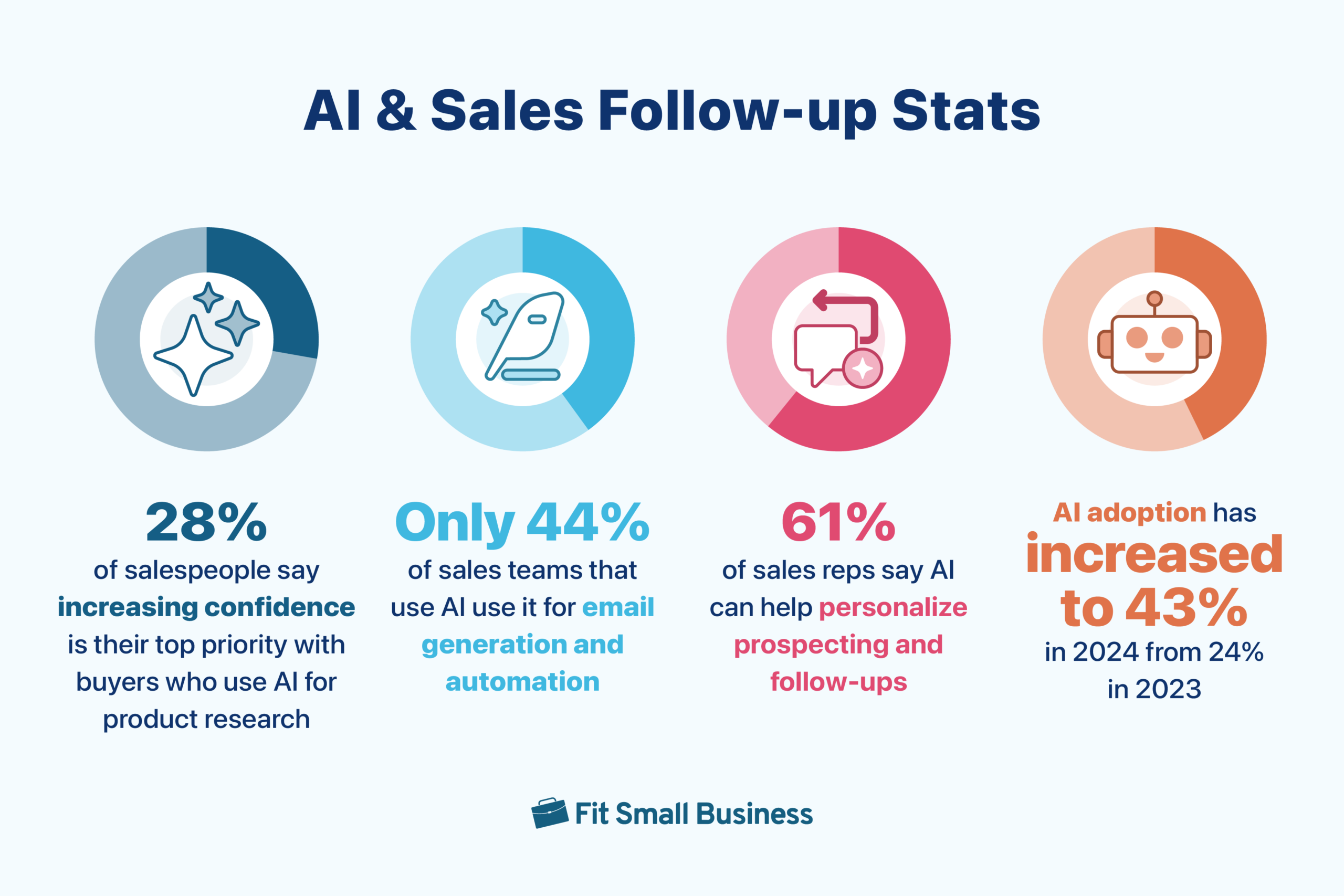
AI and sales follow-up stats can help sales teams leverage AI technology to improve sales processes and shorten sales cycles.
7. 28% of salespeople say increasing confidence is their top priority with buyers who use AI for product research
By acting as consultants and using AI, sales reps can help increase buyers’ confidence in purchase decisions. For instance, salespeople can include AI-generated product recommendations in the emails as a part of the follow-up process after a sales pitch or proposal, boosting their credibility, authority, and expertise. The same is true during and even after upselling and cross-selling, turning sales reps into customer advocates.
8. Only 44% of sales teams that use AI use it for email generation and automation
This data proves the current usage gap for AI technology in sales follow-ups. While most businesses apply AI for data management and analytics, there’s a huge opportunity to use generative AI to research and draft personalized follow-up emails and then autodeploy them on a mass scale.
9. 61% of sales reps say AI can help personalize prospecting and follow-ups
AI can help salespeople reach the right prospects at the right times with the right messaging. It’s designed to complete tasks that a human would ordinarily do. If an intelligent bot can get you personalized information on a lead and evaluate their habits, such as when they check their email inbox, those could be pertinent details in a follow-up campaign.
10. AI adoption has increased to 43% in 2024 from 24% in 2023
The surge in AI adoption among salespeople is proving progressively useful. Sales reps can use AI to summarize sales proposals and calls and perfect email messages. Sales teams can also generate follow-up emails on a mass scale without compromising personalization and overall email quality.
Find a CRM system that deploys emerging technology like AI in its toolset. Products like Salesforce, for example, have incorporated AI for many uses, including email generation. This advanced feature can help sales reps add simple follow-up inputs such as the message tone, what you’re selling, and your target audience, putting email drafting on autopilot.
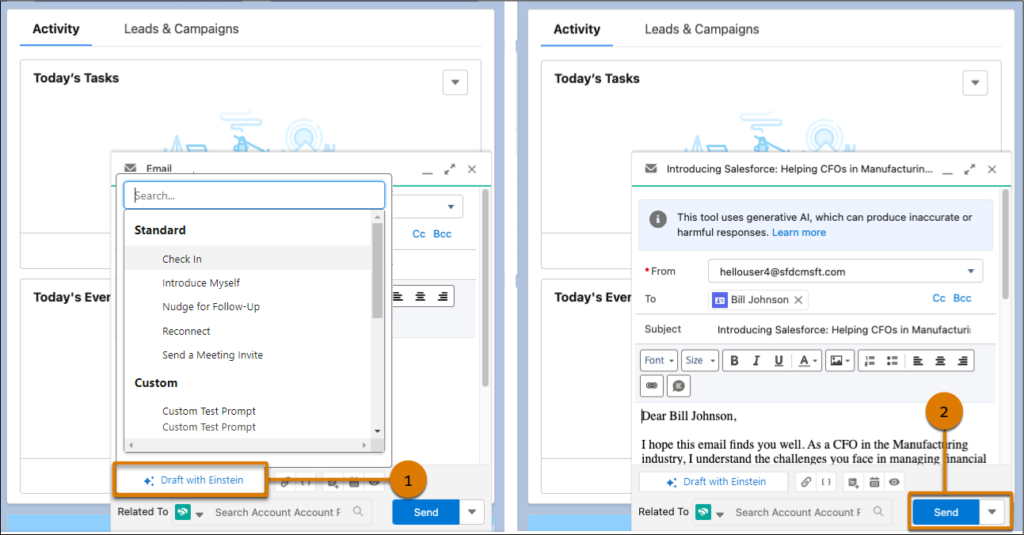
Salesforce’s AI-powered sales email generator is built into the email composer, helping salespeople quickly expand deals through personalized email content. (Source: Salesforce)
Sales Follow-up Stats on Contact Channels & Methods
In many cases, it’s not about “what” you say but “how” and “where” you say it. Understanding buyer behavior and preferences is important to ensure you’re best connecting with decision-makers on the channels they will respond to. These sales follow-up stats dive into various approaches and communication methods you can use during follow-up campaigns.

Sales follow-up statistics on contact channels and methods can help salespeople identify customers’ most preferred mode of communication.
11. 77% of B2B buyers want to be contacted via email
When determining how you will follow up with prospects, consider that most buyers prefer email as their primary contact method. This sales follow-up statistic is likely due to the nonabrasiveness of the channel, which allows recipients to read and respond on their own time instead of an inbound phone call, which puts them on the spot.
12. Mondays at 11 a.m. offer a 4.6% conversion rate, making them the best times to send follow-up emails
Many surveys and studies have been conducted to find the best time to send a prospect email. This one, however, took thousands of data sets spanning seven years and found that 11 a.m. on Mondays has the highest conversion rate. We recommend using an automated email scheduler to ensure you always send emails on time.
13. Only 5% of sellers say sending bulk emails is effective
Only a few salespeople say sending mass emails is effective. Prospects can tell if an email is mass-produced and don’t feel any pressure to engage or respond to those messages. However, that doesn’t mean you can’t send many individual messages simultaneously.
Fortunately, email tools and CRM systems have features for autoinserting personal data onto email templates that make it appear personalized.
14. Over $500,000 in revenue was generated through virtual selling, say 31% of sellers
Salespeople can sell products and services without meeting prospects in person. This is made possible by virtual or online selling, according to a 2022 LinkedIn report.
Small businesses can leverage a CRM solution’s video conferencing capability to follow up with leads. It lets you and the customer talk virtually face-to-face, allowing you to choose the best sales responses based on their reaction.
Sales follow-ups can be done using various communication methods, including phone, email, chat, and social media. CRM software, like Zoho CRM, comes with an omnichannel contact center. This robust capability can help sales reps reach out and nurture leads using all types of communications, leaving nothing to fall through the cracks.
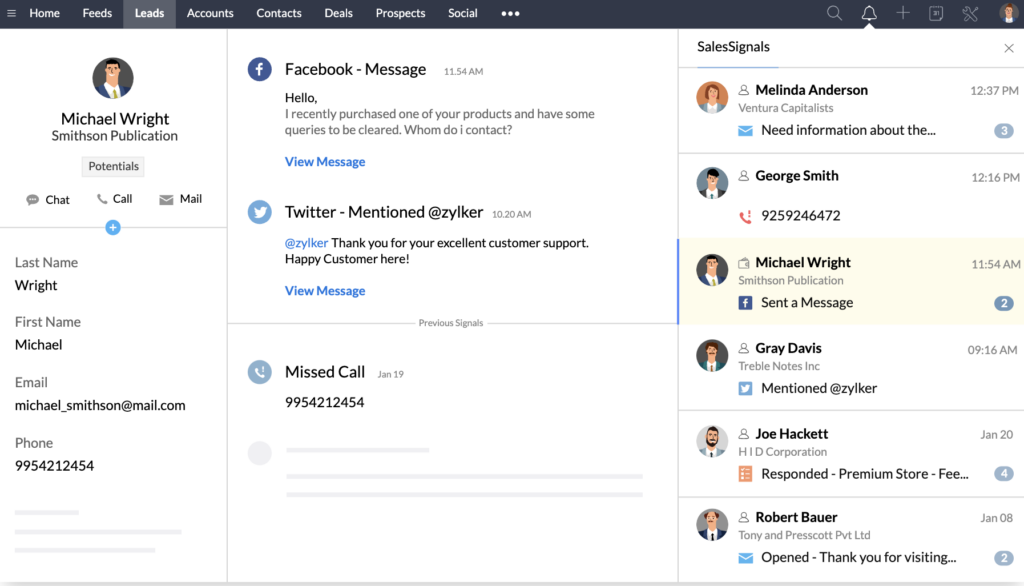
Zoho CRM has an omnichannel contact center for seamless lead outreach and nurturing. (Source: Zoho CRM)
Sales Follow-up Statistics on Content
Delivering the right message and content to leads helps keep them engaged. The result is either your business remaining in the running for a product or service, an appointment added to the calendar, or, best-case scenario, a closed deal. These follow-up statistics in sales outline how you should construct the follow-up process.

Sales follow-up statistics on content can help sales reps create the most effective online resources to attract more leads.
15. 38% of businesses use videos to generate leads and boost sales
Video is becoming the way to engage leads and people in general. About 31% of companies use video to educate prospects about product offerings. Because of its rising demand as a content source, consider using videos in your follow-up campaigns.
Rather than sending an email with lengthy text, you can attach video content to an email message explaining how your product works. Additionally, you can include a video greeting along with the follow-up email, especially during the holiday season.
16. 71% of leaders plan to roll out video messaging in their campaigns
To tie in with the previous stat, you’ll want to incorporate video for your follow-ups sooner rather than later. More and more sales teams will use video messaging in the near future, so it’s important to get on that train early that it no longer stands out as a unique contact method.
17. Using ‘Hello, [Name]’ in your follow-up greetings can have a 41% positive impact on open rates
There’s always the question of what to write in your email follow-up messages. Should you be formal, informal, or something in between? According to the data, using “Hello, [NAME]” as a greeting has the highest positive impact on open rates. Additionally, saying a less formal “Hi [NAME]” is used the most but has a 5% negative impact on opens.
18. 69% of sellers say business-relevant research data is the most influential content in connecting with buyers
Prospects want to see data before making decisions. Relevant data in email content has the most influence on conversions. As you make your follow-ups, conduct research on the person contacted and the industry you’re serving. Combine personalization with logic to encourage that lead to accept a meeting.
19. The word ‘nudge’ in a follow-up email can have a 1.09% positive impact on open rates; ‘following up’ drastically reduces success
Email prospecting data showed that using “following up,” a common phrase in email follow-ups, can reduce open rates by as much as 16.3%. Additionally, “didn’t hear back” can reduce rates by 57.61%.
This data teaches sales teams the importance of choosing the right words to encourage recipients to open emails, especially follow-up messages. Split-test different subject lines to develop the most effective open rate drivers.
20. 251-300 words is the most effective length for follow-up conversions
Many assume the “less is more” principle applies to sales emails and follow-ups. Data, however, suggests otherwise. 251-300 words is the sweet spot for getting email reads and replies. There’s a steady rise in conversion rates starting at 101 words until the 251-300 optimal zone. After 300 words, the conversion rates significantly plummet.
With email follow-ups, once you find what works, stick with it. CRMs like Pipedrive offer email template storage where sales reps can save and share optimal content outlines that get them the best results. Moreover, CRM solutions have sales follow-up email templates, saving sales agents time and effort creating content from scratch.

Pipedrive lets sales teams create and customize email templates for efficient lead outreach and follow-up. (Source: Pipedrive)
The Impact of Sales Follow-ups on Productivity Barriers
Sales professionals face challenges like hitting sales quotas, which makes follow-ups essential. Exceeding the quota is the primary goal for any sales team because it means higher incentives and commissions and greater revenue for the business. These follow-up statistics in sales outline the top barriers salespeople face and key takeaways about the role of sales follow-ups.

Sales productivity barrier statistics solvable by follow-up can help salespeople identify their pain points and those of their customers.
21. 34% of sales professionals say prospects don’t buy because they aren’t ready
Salespeople can effectively move leads who aren’t ready to purchase toward the bottom of the funnel by sending a follow-up email or call after the initial contact.
Include a link for a free product demo or a downloadable buyer’s guide in the email to help prospects realize that the best time to purchase is now. Or act as a customer advocate—instead of a mere seller—and offer a quick follow-up call for a free consultation at their most convenient time.
22. 16% of sales professionals say making direct contact with decision-makers is a top challenge
Salespeople find it hard to contact decision-makers for various reasons, such as sales transactions managed by executive assistants or outsourced third parties. A follow-up call, email, or in-person meeting with key decision-makers is crucial. For instance, a sales rep can ask the first point of contact which stakeholders they can invite to the next meeting or demo.
Such a follow-up strategy can help sales teams quickly find and convert a lead, close a deal, and, ultimately, drive overall sales. Looking for other datasets to improve your overall sales posture? Here are 29 actionable sales statistics for your small business.
23. 75% of B2B sales reps miss their quotas because of complex sales cycles
Sales professionals in B2B organizations don’t hit their quotas for several reasons, such as the complex nature of this sector’s sales cycle. With a longer sales cycle, follow-up actions are critical to prevent potential buyers from losing interest in your product or service.
To close deals faster, B2B sales teams should create more solid sales follow-up workflows, like setting up an automated email after a sales demo.
24. Sales professionals only spend about 30% of their time actually selling
Sales professionals mostly spend their time on administrative work, such as data entry and updating information in sales business systems.
CRM automation, like setting up rules for automatic replies to follow-up emails, can help salespeople focus more on customer conversations. Premade and customizable templates can help sales reps streamline email outreach and lead-generation campaigns.
Sales teams can streamline follow-up emails by using the right CRM software. With CRM automation, sales reps can set up rules so their CRM software, like Bitrix24, automatically sends a follow-up email. This email is based on specific customer actions, like after downloading your e-book, or on specific timelines, such as a week after the product demo.
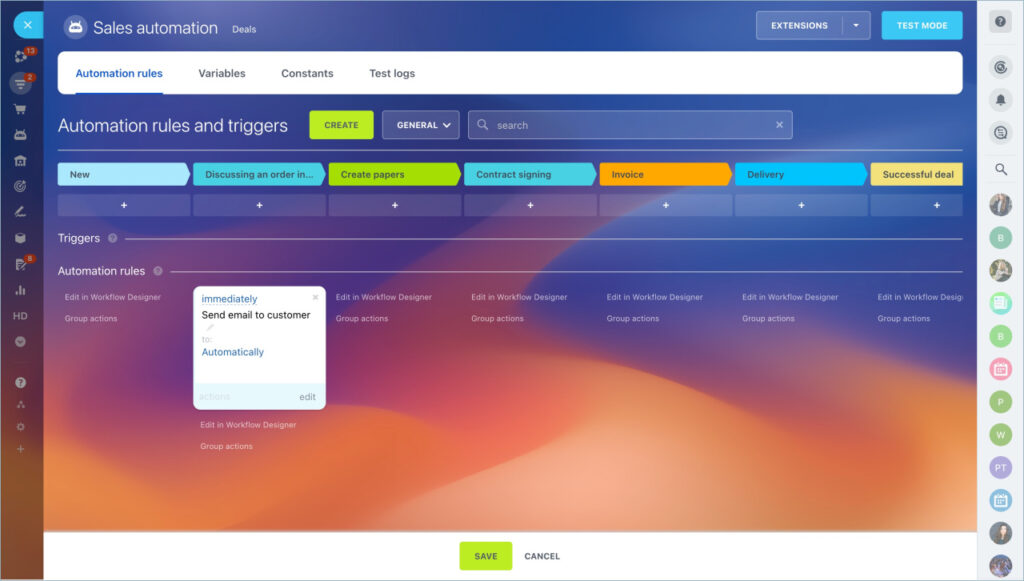
Bitrix24 enables salespeople to set up automation, such as sending a follow-up email to a customer after initial contact to determine their interest in the product or service. (Source: Bitrix24)
Bottom Line
When done right, sales follow-ups are crucial for a successful revenue operation. Sales teams can incorporate the above sales follow-up stats and findings in sales planning and outreach.
Aside from selling across multiple touchpoints and identifying the perfect timing, you can add greater value to potential buyers during follow-ups. For instance, you can add unique elements such as video messaging, social media, and AI tools to stand out from competitors.